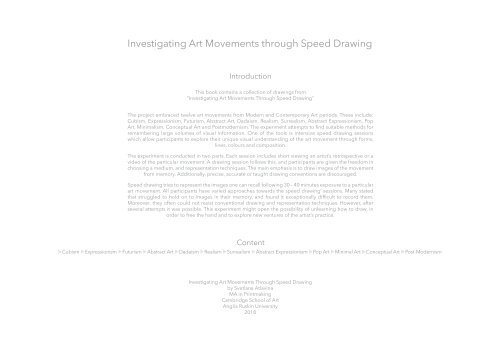Investigating Art Movements through Speed Drawing
The project embraced twelve art movements from Modern and Contemporary Art periods. These include Cubism, Expressionism, Futurism, Abstract Art, Dadaism, Realism, Surrealism, Abstract Expressionism, Pop Art, Minimalism, Conceptual Art and Postmodernism. The experiment attempts to find suitable methods for remembering large volumes of visual information. One of the tools is intensive speed drawing sessions which allow participants to explore their unique visual understanding of the art movement through forms, lines, colours and composition. The experiment is conducted in two parts. Each session includes short viewing an artist’s retrospective or a video of the particular movement. A drawing session follows this, and participants are given the freedom in choosing a medium, and representation techniques. The main emphasis is to draw images of the movement from memory. Additionally, precise, accurate or taught drawing conventions are discouraged. All images in the book are copyright protected. Please, contact the author for any type of image and text usage.
The project embraced twelve art movements from Modern and Contemporary Art periods. These include Cubism, Expressionism, Futurism, Abstract Art, Dadaism, Realism, Surrealism, Abstract Expressionism, Pop Art, Minimalism, Conceptual Art and Postmodernism. The experiment attempts to find suitable methods for remembering large volumes of visual information.
One of the tools is intensive speed drawing sessions which allow participants to explore their unique visual understanding of the art movement through forms, lines, colours and composition.
The experiment is conducted in two parts. Each session includes short viewing an artist’s retrospective or a video of the particular movement. A drawing session follows this, and participants are given the freedom in choosing a medium, and representation techniques. The main emphasis is to draw images of the movement from memory. Additionally, precise, accurate or taught drawing conventions are discouraged.
All images in the book are copyright protected. Please, contact the author for any type of image and text usage.
You also want an ePaper? Increase the reach of your titles
YUMPU automatically turns print PDFs into web optimized ePapers that Google loves.
<strong>Investigating</strong> <strong>Art</strong> <strong>Movements</strong> <strong>through</strong> <strong>Speed</strong> <strong>Drawing</strong><br />
Introduction<br />
This book contains a collection of drawings from<br />
“<strong>Investigating</strong> <strong>Art</strong> <strong>Movements</strong> Through <strong>Speed</strong> <strong>Drawing</strong>”<br />
The project embraced twelve art movements from Modern and Contemporary <strong>Art</strong> periods. These include:<br />
Cubism, Expressionism, Futurism, Abstract <strong>Art</strong>, Dadaism, Realism, Surrealism, Abstract Expressionism, Pop<br />
<strong>Art</strong>, Minimalism, Conceptual <strong>Art</strong> and Postmodernism. The experiment attempts to find suitable methods for<br />
remembering large volumes of visual information. One of the tools is intensive speed drawing sessions<br />
which allow participants to explore their unique visual understanding of the art movement <strong>through</strong> forms,<br />
lines, colours and composition.<br />
The experiment is conducted in two parts. Each session includes short viewing an artist’s retrospective or a<br />
video of the particular movement. A drawing session follows this, and participants are given the freedom in<br />
choosing a medium, and representation techniques. The main emphasis is to draw images of the movement<br />
from memory. Additionally, precise, accurate or taught drawing conventions are discouraged.<br />
<strong>Speed</strong> drawing tries to represent the images one can recall following 30 – 40 minutes exposure to a particular<br />
art movement. All participants have varied approaches towards the speed drawing’ sessions. Many stated<br />
that struggled to hold on to images in their memory, and found it exceptionally difficult to record them.<br />
Moreover, they often could not resist conventional drawing and representation techniques. However, after<br />
several attempts it was possible. This experiment might open the possibility of unlearning how to draw, in<br />
order to free the hand and to explore new ventures of the artist’s practice.<br />
Content<br />
uCubism uExpressionism uFuturism uAbstract <strong>Art</strong> uDadaism uRealism uSurrealism uAbstract Expressionism uPop <strong>Art</strong> uMinimal <strong>Art</strong> uConceptual <strong>Art</strong> uPost-Modernism<br />
<strong>Investigating</strong> <strong>Art</strong> <strong>Movements</strong> Through <strong>Speed</strong> <strong>Drawing</strong><br />
by Svetlana Atlavina<br />
MA in Printmaking<br />
Cambridge School of <strong>Art</strong><br />
Anglia Ruskin University<br />
2018





